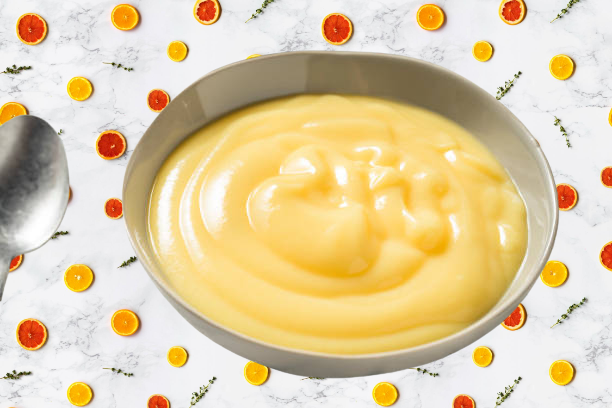Custard is a creamy, egg-based dessert that’s comforting for humans. But is this sweet, velvety pudding safe for your canine buddy to eat, too? Let’s explore Can dogs eat custard? No, dogs should not have custard, or at least not in large amounts.
Table of Contents
An Overview of Custard for Dogs
Custard is a classic dessert with egg yolks, milk or cream, sugar, and flavorings like vanilla or nutmeg. It’s thickened into a velvety pudding-like texture by cooking the egg yolks or adding cornstarch. Custard has a sweet, rich, and creamy taste that many dogs find irresistible.
So can dogs eat regular custard designed for human consumption? The answer is yes, but only in tiny quantities. Custard contains ingredients like dairy, eggs, and sugar that can cause gastrointestinal upset and Canine health if your dog overeats. A lick or two of custard as an occasional treat is delicate for most healthy dogs.
To avoid stomach issues, keep these guidelines in mind:
- Stick to a teaspoon or less of custard per treat
- Make sure your dog isn’t lactose intolerant before sharing dairy-based custard
- Monitor for signs of an eggy or sugary reaction
- Avoid serving custard in a big bowl that allows for overindulging
With just a bit of caution and moderation, letting your dog sample this yummy dessert can be a safe and exciting way to watch them experience a new flavor.
You May Also Like to Read: CAN DOGS EAT OATMEAL CREAM PIES?
Can dogs eat custard?
While custard may seem like a tasty treat to share with your furry friend, it’s best to avoid feeding dogs custard or at least limit their intake to tiny portions. Custard is high in sugar and fat and often contains ingredients that can upset a dog’s digestive system and lead to vomiting or diarrhea if consumed in large amounts.
The main concern is that custard needs to be formulated to meet a dog’s nutritional needs. The high fat and sugar content make it an unhealthy snack choice that could contribute to obesity and other issues when fed regularly. Additionally, custard typically contains dairy, egg custard, dairy, eggs, and vanilla, which can cause allergies or intolerances in some dogs.
They are unlikely to be toxic or dangerous to otherwise healthy dogs. As long as the specific ingredients are dog-safe, a lick of custard from a spoon or a small spill cleaned up off the floor is not considered high-risk. But it’s best to refrain from sharing desserts like custard with dogs or adding custard intentionally to their diet.
It’s also crucial to always check the entire list of ingredients before feeding human foods like custard to ensure nothing toxic for dogs is included, like chocolate or the artificial sweetener xylitol. When in doubt, avoid sharing any people’s foods with your dog, even sweets.
Can dogs eat fresh custard?
Fresh or homemade custard is usually made with milk, cream, eggs, and sugar. While these things are not toxic to dogs, they can cause problems if eaten in large amounts.
The main issue is that dogs often cannot digest milk and dairy products well. The large amount of cream and milk in custard may give them an upset stomach or diarrhea. Even small amounts can cause gas, vomiting, and belly pain.
Custard also has lots of sugar. A tiny lick likely won’t hurt. But too much sugar can make dogs hyperactive and lead to weight gain or diabetes.
Even though fresh custard is not immediately dangerous, it’s still best to refrain from purposefully feeding dogs custard very often or letting them eat a lot. A tiny taste once in a while of fresh custard probably won’t cause harm. But custard should not become a regular part of their diet.
No matter what type of custard it is – fresh, homemade, powdered, or canned – it is not healthy for dogs. While the occasional tiny lick of custard as a treat is unlikely to be an issue, it’s safer not to make a habit of letting your dog eat this creamy, sweet dessert.
Healthier Homemade Dog Custard Recipe
If you want to share custard more regularly with your dog, consider making a healthier homemade version. Here is an easy dog custard recipe:
Ingredients:
- 2 cups plain, low-fat yogurt
- One ripe mashed banana
- 1 tbsp. Honey or maple syrup
- 1 tsp. vanilla extract
- 1⁄4 cup melted peanut butter
Instructions:
- In a bowl, mash together the yogurt, banana, honey or maple syrup, vanilla, and melted peanut butter until smooth.
- Pour the mixture into freezer-safe containers or popsicle moulds.
- Freeze for at least 4 hours until solid.
- Serve as a cool custard treat for your dog!
This dog-friendly frozen custard delivers sweetness without refined sugar. The yogurt provides protein without the lactose and fat of dairy cream. And peanut butter adds healthy fats and flavor. Freeze smaller portions to keep calories in check.
Can dogs eat frozen custard?
Frozen custard is not recommended for dogs to eat. Even though it is a custard frozen into a cold, icy treat, it still contains the same ingredients as regular custard, like dairy, eggs, and sugar.
Since the ingredients in regular custard can potentially cause gastrointestinal upset and other health issues for dogs when eaten in large amounts, the same risks apply to frozen custard. Just because it is frozen doesn’t make it any healthier for your dog.
Can dogs eat custard cream?
No, custard cream cookies made for people are too high in sugar and fat for dogs. Trace amounts of custard cream filling are ok, but avoid feeding dogs the whole cookie.
Can dogs eat custard tarts?

It’s best not to feed your dog full custard tarts, which have buttery pastry and creamy egg custard. A custard or tart shell nib is ok, but excess fat, dairy, and sugar can cause issues.
Can dogs eat custard apples?
Custard apples are tropical fruits. The flesh is delicate for dogs in moderation, but avoid giving them seeds or cores as these contain toxins that can cause vomiting and diarrhea.
Is custard terrible for dogs?
Large amounts of dairy-heavy, sugary egg custard can be bad for dogs. But occasional, tiny tastes are refined for most dogs. Check for food intolerances and avoid overindulging to prevent gastrointestinal and weight issues.
Can dogs eat custard pie?
Avoid feeding your dog a whole slice of custard pie. The buttery crust, eggs, and sugar content won’t agree with your dog’s digestion. Small bites of just the custard portion are safer.
You May Also Like to Read: WHY BEAGLES ARE THE WORST DOGS?
Health Concerns with Dogs and Custard
While tiny tastes of custard are ok, there are some health drawbacks to be aware of before treating your dog to this food:
- High in fat, custard’s creamy richness comes from egg yolks and dairy, which can quickly lead to obesity if overfed to your dog.
- Contains lactose: The milk and cream used in custard have lactose sugars that some dogs struggle to digest, causing diarrhea.
- High in sugar: Sugar makes custard taste so sweet, but too much can cause canine obesity and dental decay.
- Raw eggs pose a risk. Uncooked eggs used in some custard recipes may harbor salmonella bacteria.
The occasional small bite likely won’t harm your dog. But eating lots of creamy, sugary custard frequently could result in stomach upset, diarrhea, vomiting, weight gain, pancreatitis, or other issues. Talk to your vet if you have any concerns.
What About Custard-Flavored Treats?
Beyond straight homemade or human-grade custard, some commercial dog treats and foods feature custard flavoring. These provide a safer way to let your dog enjoy the taste of custard without the risks of natural dairy and eggs.
Some popular custard-flavored dog treats include:
- Milk-Bone Flavor Snacks and Custard Cremes
- Bocce’s Bakery Custard Crème Donuts
- Tail Mix Custard Crunch Dog Biscuits
You may also find custard-flavored dog food like:
- Freshpet Dog Food Deli Fresh Custard
- Stella & Chewy’s Custard Crème Dinner Patties
Always check the package to ensure custard-flavored treats contain no custard, eggs, milk, or cream. Flavored products provide taste without digestive issues.
Feeding Dogs Custard Safely
Want to share a custard treat with your pup? Take these precautions:
- Ask your vet if the custard is suitable, especially for dogs with allergies, diabetes, pancreatitis or other conditions
- Start with just a lick or half-teaspoon of custard and monitor for reactions before increasing the portion size
- Choose raw egg-free custard or cook it thoroughly to reduce the risk of salmonella poisoning
- Pick lower sugar options or dilute sugary custard with plain yogurt or peanut butter
- Avoid giving custard in a bowl, as dogs may devour a large quantity quickly
- Brush your dog’s teeth after they eat custard to prevent sugar-causing dental issues
- Introduce new foods like custard gradually alongside your dog’s regular diet
With a few straightforward safety measures, your dog can enjoy custard as an occasional treat without tummy troubles or other health hazards. But contact your vet immediately if your dog experiences vomiting, diarrhea, or other concerning symptoms after eating custard. Better to feed your dogs with a small piece of chicken.
The Takeaway: Let Dogs Lick Custard in Moderation
Custard is one of those human foods that intrigues dogs with its sweet aroma and creaminess. The verdict? Dogs can eat custard safely and enjoy this yummy dessert. However, limit portions to a lick or teaspoon-sized bite. Avoid giving your dog custard bowls, which can lead to overindulging and stomach issues.
Make custard an occasional treat, not a daily habit. Monitor your dog’s reaction closely, and stop feeding it if it shows signs of food intolerance. With a little custard here and there, you can give your furry friend a fun new flavor without jeopardizing their health or diet. But always check with your vet if you have questions or concerns about sharing food with your dog.
FAQs
Can I give my dog store-bought vanilla custard?
Small portions of plain vanilla custard are delicate, but avoid those with added sugars or other flavorings. Check the ingredient label and nutrition facts carefully before feeding your dog any human desserts.
What if my dog eats a whole bowl of custard?
Small portions of plain vanilla custard are delicate, but avoid those with added sugars or other flavorings. Check the ingredients label and nutrition facts carefully before feeding your dog any human desserts.
Can puppies have custard?
Puppies under one-year-old have sensitive digestive systems. It’s best only to give them custard once they are older. Check with your vet before introducing new foods.
Can I give my dog custard as a daily treat?
Limiting custard treats to at most once a week is best. Fat, sugar, and dairy can contribute to obesity and other health issues if fed regularly long-term.
So let your dog lick up this yummy dessert, but practice moderation and care when treating your pup to custard! Consult your vet if you have any other questions about safely incorporating people’s foods like custard into your dog’s diet.







